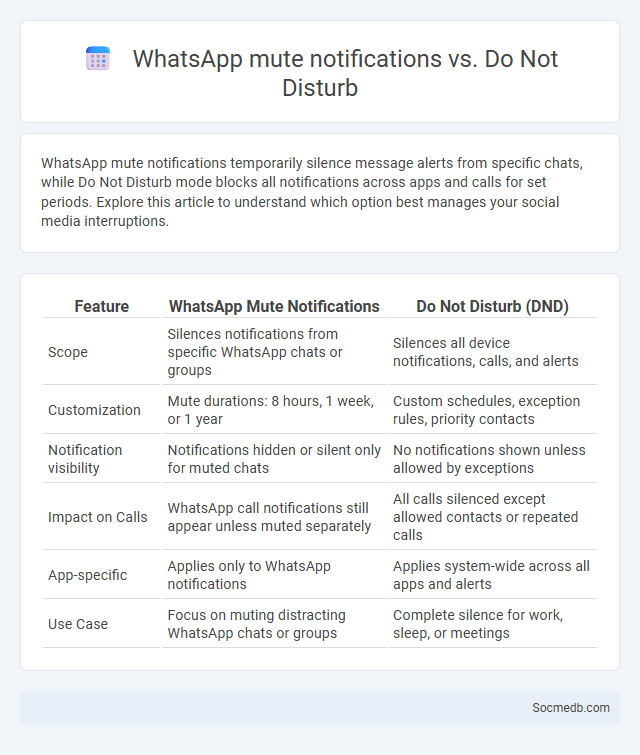
Photo illustration: WhatsApp mute notifications vs Do Not Disturb
WhatsApp mute notifications temporarily silence message alerts from specific chats, while Do Not Disturb mode blocks all notifications across apps and calls for set periods. Explore this article to understand which option best manages your social media interruptions.
Table of Comparison
| Feature | WhatsApp Mute Notifications | Do Not Disturb (DND) |
|---|---|---|
| Scope | Silences notifications from specific WhatsApp chats or groups | Silences all device notifications, calls, and alerts |
| Customization | Mute durations: 8 hours, 1 week, or 1 year | Custom schedules, exception rules, priority contacts |
| Notification visibility | Notifications hidden or silent only for muted chats | No notifications shown unless allowed by exceptions |
| Impact on Calls | WhatsApp call notifications still appear unless muted separately | All calls silenced except allowed contacts or repeated calls |
| App-specific | Applies only to WhatsApp notifications | Applies system-wide across all apps and alerts |
| Use Case | Focus on muting distracting WhatsApp chats or groups | Complete silence for work, sleep, or meetings |
Overview: WhatsApp Mute Notifications vs Do Not Disturb
WhatsApp Mute Notifications allows users to silence message alerts from specific chats or groups without affecting overall phone settings, providing customizable durations such as 8 hours, 1 week, or always. Do Not Disturb mode, available on most smartphones, mutes all notifications and calls system-wide, ensuring complete silence except for exceptions set by the user. Choosing between WhatsApp Mute and Do Not Disturb depends on whether selective message silencing or total notification blackout is needed for better concentration or rest.
What Is WhatsApp Mute Notifications?
WhatsApp Mute Notifications is a feature that allows you to silence message alerts from specific chats or groups without leaving them. By enabling mute, your phone stops sending sound or vibration notifications, helping you avoid distractions while staying connected. This option can be customized for various durations, ranging from 8 hours to a year, ensuring your focus remains uninterrupted based on your needs.
How Does Do Not Disturb Work?
Do Not Disturb (DND) on social media mutes notifications and alerts, allowing users to avoid interruptions while maintaining online privacy. It works by temporarily blocking incoming messages, calls, and app notifications from appearing on the device's lock screen or notification center. Users can customize DND settings based on time schedules or specific contacts to balance social interaction and focus.
Muting Notifications: App-Level vs Device-Level
Muting notifications on social media can be managed either at the app level or device level, each offering a unique control mechanism for your digital experience. App-level muting allows you to silence notifications from specific accounts or conversations within the social media platform, ensuring you stay focused without unfriending or unfollowing. Device-level muting, on the other hand, disables all notifications from the app entirely, giving you a broader but less granular way to manage interruptions and maintain your productivity.
Key Differences Between WhatsApp Mute and Do Not Disturb
WhatsApp Mute silences notifications from specific chats or groups, allowing you to block message alerts without affecting calls, while Do Not Disturb (DND) mode mutes all notifications across your device, including WhatsApp calls and messages, based on your system settings. Muting a chat maintains your ability to receive messages silently, whereas DND restricts all notifications and interruptions, helping you focus without distractions. Understanding these key differences helps you customize your notification preferences to manage Your social media interactions effectively.
Pros and Cons of WhatsApp Mute Notifications
WhatsApp mute notifications improve focus and reduce stress by silencing group chats or individual contacts for specified periods, helping users avoid constant distractions. However, muting important conversations may lead to missed urgent messages or delayed responses, potentially impacting personal and professional communication. Balancing notification settings enhances user control but requires mindful management to stay informed without feeling overwhelmed.
Pros and Cons of Using Do Not Disturb Mode
Using Do Not Disturb mode on social media helps you maintain focus by minimizing interruptions from notifications, which can improve productivity and mental well-being. However, activating this mode may cause you to miss important messages or real-time updates, potentially affecting timely communication. Balancing your use of Do Not Disturb ensures you protect your time while staying connected when necessary.
When to Use WhatsApp Mute vs Do Not Disturb
Use WhatsApp Mute to silence notifications from specific chats or groups that are temporarily distracting without affecting other app alerts. Do Not Disturb mode is ideal for minimizing all notifications on your device during focused work hours or sleep, preventing interruptions from calls, messages, and apps. Selecting the appropriate option depends on whether you need targeted silencing or complete notification control to maintain productivity and peace.
Step-by-Step: Mute WhatsApp Notifications
To mute WhatsApp notifications, open your chat, tap the contact or group name at the top, and select "Mute Notifications." Choose the desired duration--8 hours, 1 week, or Always--and confirm your selection. Your muted chats will no longer send alerts, helping you control distractions effectively.
Step-by-Step: Activate Do Not Disturb on Your Phone
To activate Do Not Disturb on your phone, access the Settings app and locate the Do Not Disturb option, typically found under Sound or Notifications. Toggle the feature on and customize settings to silence calls, messages, and social media notifications during specific times or events. This step-by-step process helps minimize distractions and enhances focus by controlling alerts from platforms like Instagram, Facebook, and Twitter.
 socmedb.com
socmedb.com